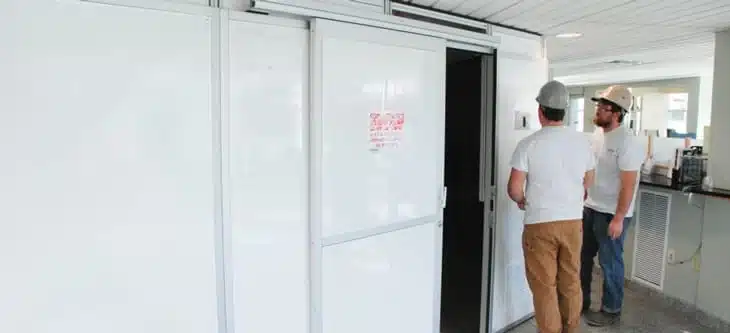
Written by Gearhart and Associates, LLC. for STARC Systems, Inc. Gearhart and Associates are industry experts in Infection Control Risk Assessment (ICRA) training, Infection Control and Prevention Strategies, and Facilities Risk Management.
Utilizing a safe and secure temporary wall containment system is a critical part of the development and execution of an effective ICRA protocol.
Healthcare practitioners, general contractors, and facility staff need to be confident in wall containment systems that not only support infection control goals but also provides sound attenuation, eliminates the introduction of dust and debris, can be easily installed and dismantled, and allows for operations to continue without disruption.
There are many different options in the containment/barrier management space. It is the responsibility of the hospital’s Infection Preventionist (IP) to ensure that the systems and technologies being used in the facility are adequate to perform the necessary containment and disinfection. Below are common options for temporary wall containment. What is the most effective?
Drywall Partitions
For years, drywall barriers have been the traditional option for contractors and restoration companies. These walls are typically constructed out of metal studs and sheetrock and take hours, sometimes days to erect. Often a barrier of poly sheeting must be erected to contain the dust and debris generated during the construction of the drywall partitions. After each use, these partitions have to be broken down and thrown away requiring a new structure be installed for each phase of work. Costs rise due to excessive labor hours, materials, and disposal fees that comes with drywall solutions. These barriers cannot be reused for other jobs, making them is expensive and the waste adds to our landfills.
Plastic Sheeting Partitions
Plastic sheeting containment is commonly constructed using metal studs, PVC piping or telescopic poles as a barrier frame then covered or wrapped with thick flame-resistant plastic sheeting. The process of erecting this kind of containment requires the measuring and cutting of sheeting to fit the area that needs to be contained. Similar to a tarp, plastic sheeting is easily damaged and must be repeatedly inspected for rips and tears. The sheeting is not easily cleanable and does not provide any sound reduction, and cannot meet ICRA Class IV requirements, which is necessary in the healthcare space.
Upon completion of the project, the plastic sheeting must be disposed of, the structure dismantled, and rebuilt with new sheeting for the next phase of work.
Polycarbonate Partition Systems
Polycarbonate partitions are sometimes used as a dust barrier in infection control containment solutions. These panel-configured walls come in multiple sizes, multiple levels of transparency and opacity, and can be fitted with custom fasteners and ports for integration with air control systems and other tools.
While many polycarbonate panel systems are cleanable and reusable, they are not very stable options and most do not seamlessly integrate into a healthcare facility’s look and aesthetic.
The STARC Systems Containment Systems
The STARC Systems was specifically designed to address issues with the barrier options listed above, exceeding ICRA Class IV requirements, providing an attractive fully integrated contained space.
STARC’s real wall appearance presents as a part of the facility. With an adjustable height range of 6’-10” to 10’-3”, 100 feet of the easy panel connection system can be erected in an hour. Anodized aluminum frames hold galvanized steel-backed, white aluminum faced panels made airtight by a pliable foam ceiling and base gaskets.
The system was designed for rapid assembly and tear down, reducing setup and teardown time which, in turn, reduces labor costs. As many projects require multiple phases from start to finish, the reusable containment walls can be stored easily and moved throughout the compromised area quickly on commercial grade carts. The panel’s sound attenuation properties reduce noise from renovation up to 50% increasing patient satisfaction scores.
When vetting all of these different containment options and systems, the cost savings, improved patient satisfaction, disruption-free installation, real wall appearance, sound attenuation, and durability makes STARC Systems the obvious choice in temporary wall containment management.
